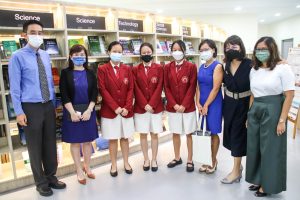Why Singapore’s English Teachers Should Embrace Singlish, Not Fight It
Is it time for Singaporean educators to embrace Singlish as a legitimate learning tool? What the Research […]
Read More
A former secondary school teacher, Associate Professor Loh Chin Ee from NIE’s English Language and Literature Academic Group now advocates for students’ access to reading resources and practices. Her research interests are in literacy and equity, with a current focus on reading in print and digitally and school libraries. She is the co-editor of Little Things and Poetry Moves, two literature anthologies that are used in schools, and have been used to explore how literature supports place-based pedagogies. In this section, she shares some insights on how education research can impact schools and what makes a good library.

Education research can inform decision-making at school and national policy level, influence teachers’ thinking and help with envisioning educational futures.
Firstly, education research inform decision-making at school and national policy level. Educators can draw on existing research for decision-making, gather data about outcomes to determine effectiveness of interventions, and collect local evidence for dynamic school-relevant decision-making.
Secondly, education research influence teacher thinking and as a result, shape practice. Vygotsky’s Zone of Proximal Development which identifies the space where students can learn new skills with expert guidance is an example of a well-used conceptual tool to aid teacher thinking and practice about everyday curricular and classroom practices.
Finally, education research help us envision what the future of education, and society, should look like. For instance, sociologists study the social factors that influence schooling to question what makes for a just educational system in terms of distribution of and access to educational resources. These findings can inform macro-policies about allocation of funding and distribution of resources to support learners from different social backgrounds and with varied needs.
Well-designed, stocked and supported school libraries are crucial to maximize students’ independent reading and learning in schools.
An important feature of good libraries is that they stock high-quality and high-interest books. Loan rates increase when the collection quality improves as students are more motivated to read. Ways to keep the print collection fresh include asking students for suggestions and utilizing the National Library Board e-reads as a complementary strategy. Giving students time to read and curating exciting programmes around reading can also draw students into the library. We have also learnt that school libraries are inclusive spaces that support student well-being.
Schools looking to redo their library space should begin by identifying the core functions of the library and considering their students’ needs before organizing the space to support these functions. The project’s 21st century school libraries framework, which has been integrated into MOE guidelines, provide a useful starting point for thinking about what is important to your school library to support your students’ reading and learning needs.

Associate Professor Loh Chin Ee at the launch of the Cedar School Library with Mr Ong Chin Meng (HOD English), Mrs Chan-Tey Kah Hwee (School Principal), Skyler Ng, Lim Qianwei and Lisa Lim (former Cedarians involved in the library redesign project), Dr Elizabeth Pang (MOE), and Ms Gemma Pereira (Library Coordinator).
There are so many things that need attention and there is so little time! I am currently working on an edited collection, tentatively titled International Perspectives on the Reading Lives of Teens in Contemporary Times, with chapter contributions from around the world. By collating diverse perspectives of adolescents’ independent print and digital reading, the edited collection will become a resource for scholars, policymakers, and educators to learn from each other.
As a researcher who works primarily from ethnographic perspectives, I immerse myself in school and out-of-school communities to observe the everyday literacy practices of individuals. Given the many changes in the educational system from the issuance of the personal learning device, full subject-based banding, and rapid technological changes, I would like to conduct a longitudinal study of adolescents’ reading in print and digitally over time to better understand how their ways of reading for leisure and to learn shift in response to these changes. An ecological, historical and lifespan approach that considers learning over time may provide perspectives to improve educational policy and practice for greater equity and effectiveness.
To read more about Chin Ee’s work on school libraries, you may refer to the project website.